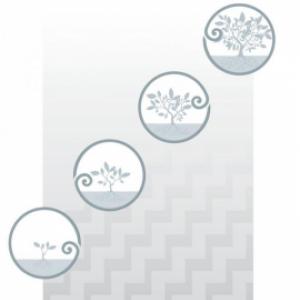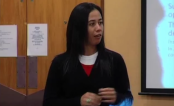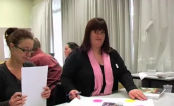Te Aho Arataki Marau mō te Ako i Te Reo Māori - Kura Auraki
Curriculum Guidelines for Teaching and Learning Te Reo Māori in English-medium Schools: Years 1-13
Curriculum guidelines 521 PDF (PDF, 4 MB)
Page navigation:
Ngā ara reo me ētahi horopaki mō te ako i te reo
Language modes and possible contexts for language learning
At each curriculum level, there are suggestions for what students should be achieving in each of the six ara:

whakarongo – listening
Kei tēnei tohu ka kitea nga io-rongo hei kawe i ngā oro mai i nga taringa ki te roro.
This symbol represents the ear. The three thin lines in the design represent the auditory nerve that carries sound from the ear to the brain.

pānui – reading
He pikitia tēnei o ngā whārangi pukapuka.
This symbol represents the pages in a book.

mātakitaki – viewing
Kei tēnei tohu ko te pouaka whakaata.
This symbol represents the screen of a computer monitor or television set.

kōrero – speaking
Kei tēnei tohu ko te moko kauae e whakaatu ana.
This symbol derives from the moko kauae, the traditional tattoo on the chin. It is used to represent the speaking language mode.

tuhituhi – writing
Kei tēnei tohu ngā taputapu tārai kōrero i whakamahia e ngā mātua tipuna hei hanga kōrero i ngā whakairo, i ngā tukutuku me ngā kōwhaiwhai o te mara.
This symbol represents a pen. It derives from the designs used in Maori visual arts like carvings, lattice panels and scroll rafter paintings.

whakaatu – presenting
Kei tēnei tohu ka whakatuhia te tihi o tētahi maunga hei atamira mō te whakaatu.
This symbol represents the peak of a mountain as a stage to present from.
At each level, there are also possible contexts for introducing, practising, and revising language in meaningful situations. These include:
- socio-cultural themes, for example, manaakitanga (hospitality)
- topics, for example, routines and procedures on the marae
- text types, for example, waiata Māori.
Language associated with the achievement objectives can be introduced in the context of relevant socio-cultural themes, topics, and text types. For example, language associated with achievement objective 3.1 (communicate, including comparing and contrasting, about habits, routines and customs) could be introduced in the context of a short dialogue in which two speakers associated with different marae compare ways of extending hospitality to guests at their own marae. The short dialogue would include familiar language along with at least one clear example from each speaker of how habits or routines can be expressed in te reo Māori. That example (or a series of examples) could then provide the basis for teaching this particular aspect of te reo Māori. In this way, the teaching of the language would take place in a relevant cultural context.
The socio-cultural themes included in these curriculum guidelines provide possible tikanga Māori content. Although the themes suggested at each level have been selected with that level’s achievement objectives in mind, they can also be introduced effectively at other levels. The possible socio-cultural themes, such as whanaungatanga (relationships) and manaakitanga (hospitality), are intended to be neither exhaustive nor exclusive. The socio-cultural content at each level should be relevant to students’ lives and yet varied enough to retain their interest.
The topics suggested at each curriculum level, such as whānau relationships and tangihanga (funerals), have also been selected with the achievement objectives for that level in mind. Teachers are encouraged to integrate some of these topics with others of their own choice or decide to reassign topics to a different level.
At each curriculum level, different text types are also suggested. They have been selected for their relevance to the achievement objectives and include Māori-specific text types, for example, mōteatea (traditional Māori songs and chants) and karakia (prayers). Examples of more general written texts are email messages and shopping lists. Spoken texts include announcements and conversations. As with the possible socio-cultural themes and topics, these curriculum guidelines present only selected examples of text types because it is expected that teachers will supplement these with others that are relevant for their students.
The following table lists some of the achievement objectives for particular curriculum levels alongside some of the language learning contexts (socio-cultural themes, topics and text types) suggested for that level in order to highlight possible connections.
Examples of relationships between achievement objectives and language learning contexts
|
Achievement objective |
Possible socio-cultural themes | Possible topics | Possible text types |
|
2.4 Communicate about time, weather and seasons |
Te wā (time, seasons, lunar calendar) | Weather and seasons | Simple, short dialogues; simple weather reports |
|
2.3 Communicate about likes and dislikes, giving reasons where appropriate | Te whānau (the family, belonging) | Food preferences | Simple, short dialogues; questionnaires |
|
3.4 Communicate, including comparing and contrasting, about how people travel |
Te marae (attending events at the marae) | Modes of transport | Informal and semiformal conversational exchanges; maps and plans |
|
4.3 Communicate about obligations and responsibilities |
Whanaungatanga (relationships); tuakana–teina | Roles and duties at home, in the community and at school | Informal and semiformal conversational exchanges; rules and regulations; whakataukī (proverbs); pepehā (iwi specific sayings) |
Teachers select achievement objectives, themes, topics and text types to develop specific learning outcomes and activities that best fit their students’ learning needs. For example, a suitable learning outcome at level 2 might be: 'We are learning to talk about weather, asking and saying what the weather is like in different places.' A suitable learning activity might be for the students to role-play a telephone call with a friend in a different part of New Zealand. The success criteria for this learning outcome might be: 'I’ll know I’ve achieved this learning outcome when I can:
- ask what the weather is like where my friend is
- say what the weather is like where I am
- draw symbols to indicate the weather on simple pictures of the two different places
- label the pictures by writing a simple statement comparing the weather in the two places.'
See also the section on monitoring achievement.
As students progress through the curriculum levels, they will increase their competence in skills relating to all the ara reo, both receptive skills (listening, reading and viewing) and productive skills (speaking, writing and presenting). At level 1, for example, students are encouraged to 'write simple, familiar words, phrases and sentences using the conventions of written language ...', whereas at level 3 they are expected to 'use resources (for example, dictionaries and glossaries) to experiment with some new language in writing ...'.




